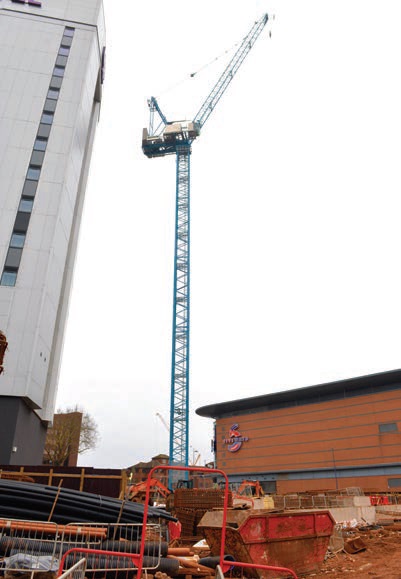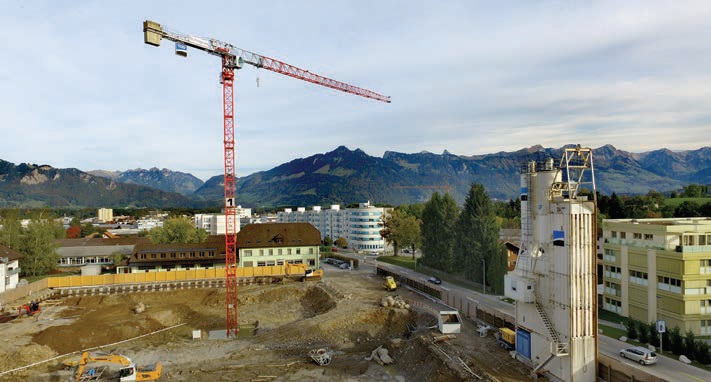Innovation Drive
3 October 2019A number of tower crane models are at the final stages of development at Saez’s factory, one of which claims a world title. Sotiris Kanaris talks to sales representative Juan Ballester about the upcoming launches.
This year’s product launches for Saez started with the introduction of the 10t capacity SLH 205, which was the highlight of its Bauma stand.
The manufacturer says this new hydraulic luffer has a very tight out-of-service radius and a very fast and simplified erection process. These characteristics, alongside its 55m jib and 2.6t tip load, made this crane popular very quickly, with Ballester saying that 16 units have already being sold.
Every year, Saez ships units from its SL standard cable luffing crane family and its SLH range of hydraulic luffing-jib cranes to numerous countries in different continents. The most popular markets for Saez luffers are the UK (58 luffers sold in the last 18 months), Australia and South Korea.
The manufacturer is investing in constantly expanding and updating both ranges, with some models designed with particular markets in mind.
“When you go to different markets around the world, each market has different requests; the more we expand our range of cranes, the more markets we can catch,” Ballester says.
In order to accommodate the requirements of the Australian and Asian markets for a fast, single-line crane, Ballester says the company has developed a new rope luffer, the SL 450R. “The new SL 450R is like the SL 450, but it can lift 12t in one fall and 24t in two falls. So instead of being a four-fall crane it is a two-fall one. Also, instead of having a 93Kw hoist mechanism, it has a 123Kw hoist winch.”
Saez is also working on the SLH 75, a smaller hydraulic luffer with an out-of-service radius of 4.5m and a 40m jib length. Ballester says this crane model will be highly requested in the UK, with London Tower Cranes having already placed an order for four units. He adds that the prototype is going to be erected in November.
Another product under development is the SLH 300, which the company says will be the biggest hydraulic luffer in the market. Ballester explains that a competitor has in its portfolio a bigger unit, but has not produced one to date.
“The SLH 300 will be finished and erected hopefully by the end of this year, it will be the biggest hydraulic luffing-jib crane currently in the market. It is going to have a maximum capacity of 16t and will be able to lift 3t at 60m.”
Saez estimates that around 30% of the total sales (excluding selferectors) this year will be of luffers and 70% of flat top cranes. The main markets for Saez’s TLS range of flat tops are the UK, Germany, France, Switzerland and Ireland.
For another year the bestselling model across the whole portfolio will be the TLS 65B, which has a capacity of 10t, 65m jib and tip load of 2t.
“We have been making this crane for a long time. In 2016 we upgraded this crane from 8t to 10t and we put 400kg more capacity at the tip, that is why instead of TLS 65 we call it 65B,” he explains.
Earlier this year Saez launched the TLS 6014 flat top, which has a maximum capacity of 6t and a 60m jib. This crane belongs to the new-generation, PLC-controlled cranes that comply with the latest European standards and feature IP55 mechanisms and more control possibilities, such as incorporated zoning system, remote diagnosis, Eco mode and Super-Lift mode.
Ballester reveals that another flat top will be launched in the coming months, the TLS 75 14T. “It is going to be a model between our current TLS 70 12T and TLS 75 16T,” he adds. This crane is developed to fill the gap between these two models, in response to market requests.
Saez is also working on updating and enhancing its selferectors. There will be an update of the H24, H28 and H32 models. “We are changing their design and all of the electrical parts on these cranes, to thoroughly modernise this range, making them more efficient and compliant with the new European regulations.”
The range will be enhanced with the addition of the H45 hydraulic self-erector, and with the HT 47.13 telescopic self-erector.
Featuring two-fall technology, the HT 47.13 will have a maximum capacity of 6t, 47m jib and will be able to lift 1.3t at tip end. It will also have the option to climb to 38m without derating the load chart.
The H45 will be the second 45m hydraulic crane in the market, and will have 26m maximum under hook height. It will feature hydraulic outriggers, single-phase power, zoning system and remote diagnosis.
Ballester says that producing so many models incurs high costs for the company, but the company wants to continue to launch three or four new models a year to enhance its position in the global tower crane market.
“We have engineers and we have the financial capability to expand and to complete the range. We want to be present in all the markets of the world and in order to do this we need a full range of cranes, as our intentions are to become one of the main world players in tower cranes.”

